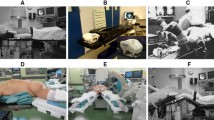Abstract
The objective of this study is to update the two previous meta-analyses in order to evaluate the efficacy and safety of percutaneous nephrolithotomy (PCNL) for patients in the prone position versus supine position. An electronic database search of MEDLINE, EMBASE, google scholar, and the Cochrane library was performed up to June, 2013. All studies comparing prone with supine position for PCNL were included. The outcome measures were stone-free rate, operative time, complication and hospital stay. Two randomized controlled trials (RCTs) and 7 non-RCTs, including 6,413 patients (4,956 patients in the prone position group and 1,457 patients in the supine position group), met the inclusion criteria. Meta-analysis of extractable data showed that PCNL in the supine position was associated with a significantly shorter operative time (WMD: 21.7; 95 % CI 2.46–40.94; p = 0.03) but lower stone-free rate (OR: 1.36; 95 % CI 1.19–1.56; p < 0.0001) than PCNL in the prone position. There was no difference between the two positions regarding hospital stay (WMD = 0.05; 95 % CI −0.16–0.25; p = 0.66) and complication rate (OR: 1.1; 95 % CI 0.94–1.28; p = 0.24). In conclusion, the present study found different results from the two previous meta-analyses results regarding stone-free rate; PCNL in the supine position had a significantly lower stone-free rate than that in prone position.



Similar content being viewed by others
References
Fernström I, Johansson B (1976) Percutaneous pyelolithotomy. A new extraction technique. Scand J Urol Nephrol 10(3):257–259
Ibarluzea G, Scoffone CM, Cracco CM et al (2007) Supine Valdivia and modified lithotomy position for simultaneous anterograde and retrograde endourological access. BJU Int 100(1):233–236
Duty B, Okhunov Z, Smith A, Okeke Z (2011) The debate over percutaneous nephrolithotomy positioning: a comprehensive review. J Urol 186(1):20–25
Liu L, Zheng S, Xu Y, Wei Q (2010) Systematic review and meta-analysis of percutaneous nephrolithotomy for patients in the supine versus prone position. J Endourol 24(12):1941–1946
Wu P, Wang L, Wang K (2011) Supine versus prone position in percutaneous nephrolithotomy for kidney calculi: a meta-analysis. Int Urol Nephrol 43(1):67–77
Hozo SP, Djulbegovic B, Hozo I (2005) Estimating the mean and variance from the median, range, and the size of a sample. BMC Med Res Methodol 20(5):13
Shoma AM, Eraky I, El-Kenawy MR, El-Kappany HA (2002) Percutaneous nephrolithotomy in the supine position: technical aspects and functional outcome compared with the prone technique. Urology 60(3):388–392
McCahy P, Rzetelski-West K, Gleeson J (2013) Complete stone clearance using a modified supine position: initial experience and comparison with prone percutaneous nephrolithotomy. J Endourol 27(6):705–709
Mazzucchi E, Vicentini FC, Marchini GS, Danilovic A, Brito AH, Srougi M (2012) Percutaneous nephrolithotomy in obese patients: comparison between the prone and total supine position. J Endourol 26(11):1437–1442
Sanguedolce F, Breda A, Millan F, et al (2012) Lower pole stones: prone PCNL versus supine PCNL in the international cooperation in endourology (ICE) group experience. World J Urol
Wang Y, Hou Y, Jiang F, Wang Y, Wang C (2012) Percutaneous nephrolithotomy for staghorn stones in patients with solitary kidney in prone position or in completely supine position: a single-center experience. Int Braz J Urol 38(6):788–794
Valdivia JG, Scarpa RM, Duvdevani M et al (2011) Supine versus prone position during percutaneous nephrolithotomy: a report from the clinical research office of the endourological society percutaneous nephrolithotomy global study. J Endourol 25(10):1619–1625
Amón Sesmero JH, Del Valle González N, Conde Redondo C et al (2008) Comparison between valdivia position and prone position in percutaneous nephrolithotomy. Actas Urol Esp 32(4):424–429
De Sio M, Autorino R, Quarto G et al (2008) Modified supine versus prone position in percutaneous nephrolithotomy for renal stones treatable with a single percutaneous access: a prospective randomized trial. Eur Urol 54(1):196–202
Falahatkar S, Moghaddam AA, Salehi M, Nikpour S, Esmaili F, Khaki N (2008) Complete supine percutaneous nephrolithotripsy comparison with the prone standard technique. J Endourol 22(11):2513–2517
Miano R, Scoffone C, De Nunzio C et al (2010) Position: prone or supine is the issue of percutaneous nephrolithotomy. J Endourol 24(6):931–938
de la Rosette JJ, Tsakiris P, Ferrandino MN, Elsakka AM, Rioja J, Preminger GM (2008) Beyond prone position in percutaneous nephrolithotomy: a comprehensive review. Eur Urol 54(6):1262–1269
Autorino R, Giannarini G (2008) Prone or supine: is this the question? Eur Urol 54(6):1216–1218
Falahatkar S, Asli MM, Emadi SA, Enshaei A, Pourhadi H, Allahkhah A (2011) Complete supine percutaneous nephrolithotomy (csPCNL) in patients with and without a history of stone surgery: safety and effectiveness of csPCNL. Urol Res 39(4):295–301
Wells G, Shea B, O’Connell D, et al The Newcastle-Ottawa Scale (NOS) for assessing the quality of nonrandomized studies in meta-analyses. Ottawa Health Research Institute Web site. http://www.ohri.ca/programs/clinical_epidemiology/oxford.htm
Conflict of interest
The authors declare that there is no conflict of interest.
Author information
Authors and Affiliations
Corresponding author
Additional information
X. Zhang and L. Xia contributed equally to this work.
Rights and permissions
About this article
Cite this article
Zhang, X., Xia, L., Xu, T. et al. Is the supine position superior to the prone position for percutaneous nephrolithotomy (PCNL)?. Urolithiasis 42, 87–93 (2014). https://doi.org/10.1007/s00240-013-0614-3
Received:
Accepted:
Published:
Issue Date:
DOI: https://doi.org/10.1007/s00240-013-0614-3




